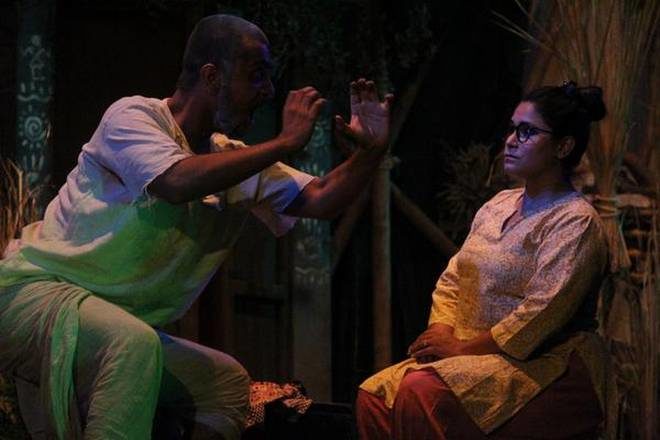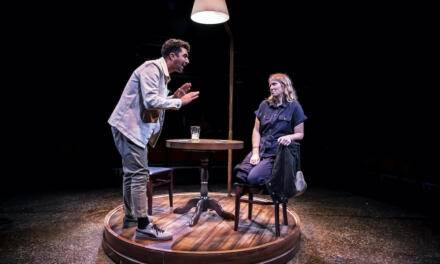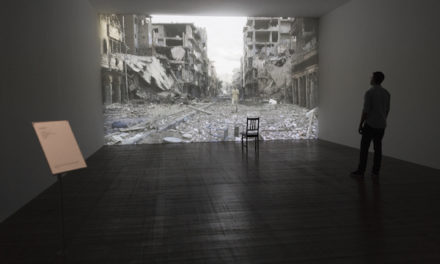Incorporating elements of post-modernism, surrealism and realism, Anjon Bose’s Garbh focuses on rural distress and disintegration of joint family system.
Formed in 1992, Sanstapak has created a niche for itself as a group committed to produce artistically significant plays to reflect social antagonism. Another distinctive feature of the group is that its dedicated artists produce plays both in Bengali and in Hindi to reach out to wider audience. This past week we have seen its Garbh, Sreemoyee Dasgupta’s Hindi translation from Bengali presented at B.C Pal Auditorium before a discerning audience.
The play is designed and directed by Anjon Bose who played the main role in the original Bengali version staged about a decade ago under the direction of playwright Torit Mitra. Structurally and thematically, Garbh is a complex and multi-layered piece of dramatic art which incorporates elements of post-modernism, surrealism and realism focusing on rural distress and disintegration of a joint family. Though playwright, Mitra is inspired by Sam Shepard’s Buried Child, he has set an action in Chhattisgarh in the context of fast-changing forces responsible for making farmers’ families dysfunctional. In comparison, Garbh deals with different social milieu with its distinct rituals and sensibility, though the motive for an action of morbid dramatis personae is broadly similar – the murder of an infant. Garbh has a new and a powerful character of an adopted child. Both the biological origin of the adopted son and murder are kept secret. But the sense of guilt causes anguish and impenetrable gloom.
Attachment to land
The patriarch is an incorrigible alcoholic who is totally ineffective but remains deeply attached to the land and its inherent quality of production from its womb. He talks about the process of how a farmer tills his land, sows the seeds which grow, creating a beautiful spectacle with its life-affirming power. And then he is filled with anger, condemning his two sons incapable of becoming the true farmer. He decides to give his land to those who really revere the fertility of Mother Earth. But this is not the main dilemma of the patriarch; his main dilemma is to keep the family secret.
The entire action takes place in the large room of Sukhdev Puswa who is bed-ridden, abusive and suffers from mood swings. Sumri Devi is Sukhdev’s wife who constantly nags him. That degenerates into a fierce verbal fight between the husband and the wife. Aghan, the eldest son who joins Naxalite movement is arrested and tortured. Already heartbroken from his past guilt, he has now no willpower to rebuild his life. Sukhdev hates him for his betrayal of landless farmer’s cause. Budhuva is the second son, a criminal and an amputee. He is full of anger and demands that his father give him the right of ownership of his land.
The way these dramatis personae behave is bizarre. They shout at each other and then talk in a realistic manner. They seem to have been haunted by the guilt of committing a heinous murder years ago of two innocent people — an infant and a young woman. Even in the moments of heightened provocation, they don’t reveal the family secret.
Two characters–Vishveshwar Puswa and his fellow researcher at Delhi University–enter the scene which deepens the mystery. Through the penetrating vision of fellow researcher, Swarnarekha Chakrabarty, layers after layers of foul murder are revealed. The whole family is in turmoil, forced to confront one another as the partner of a gory inhuman act. The searching questions asked by the young lady researcher acquire momentum leading to the climax that stuns the audience.
The director has designed his production that blends the elements of expressionism and realism. The use of two large pieces of fabric with different colors as the backdrop adds a dreamlike atmosphere reinforcing mystery and fear of the unknown. On the right upstage on a raised platform the elder son stays most of the time. Demoralised, he has alienated himself from the family and prefers to live in a dream world. He mostly stays near a scarecrow, symbolizing a figure without substance and life. There are also elements of ritualistic theatre, a sham act to escape guilt. The director and actors sustain a tense atmosphere throughout the show. However, the tense atmosphere could have become deeper if the director had shown restraint in the treatment of off-stage music. Similarly, the director should have shown ingenuity in the treatment of the scene where the lady researcher dares to enter the forbidden room where years ago murders were committed to evoking the sense of horror. It is enacted rather abruptly.
Fine performances
The dialogue delivery by two characters—Vishweshwar and the research student from Delhi University—is articulate. In contrast, the dialogues spoken by other characters have a certain kind of ambiguity and mystery. Rational thinking is alien to them. Sukrit Gulati as Sukhdev Puswa, Paroma Bhattacharya as Sukhdev’s wife, Sourah Saini as elder son Aghan and Sachin Bisht as the younger son with an artificial leg give riveting performances.
This article originally appeared in The Hindu on June 29, 2018, and has been reposted with permission.
This post was written by the author in their personal capacity.The opinions expressed in this article are the author’s own and do not reflect the view of The Theatre Times, their staff or collaborators.
This post was written by Diwan Singh Bajeli.
The views expressed here belong to the author and do not necessarily reflect our views and opinions.


















